Introduction
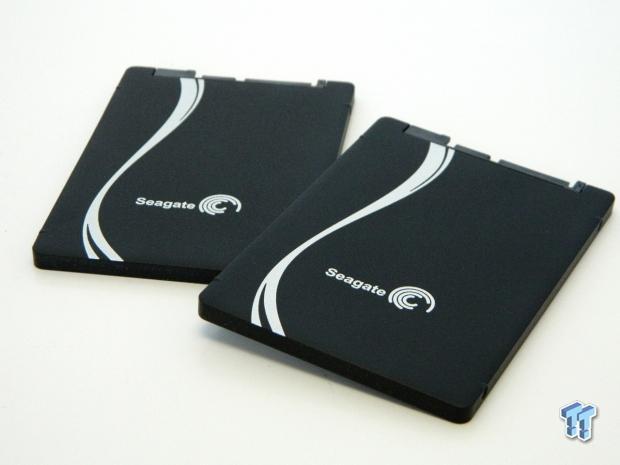
Today we are going to take another look at Seagate's 600 series SSD. We've already checked out the 240GB Seagate 600 running in RAID 0, and found it to be a blistering fast, enthusiast-class SSD, with the most predictable, and consistent, long term performance of any SSD array we've tested to date.
Today we have a larger, yet smaller, version in the 600 series line of SSD's. Yes, you read that right: smaller, and larger, at the same time. The pair of 480GB drives we've got on the bench today are a larger capacity, yet they are physically smaller than the 240GB 600's we reviewed a few reports ago. Seagate is the only SSD manufacturer I know of that has brought a 5mm thick variant to the market. There are other companies that plan to release 5mm thick drives, but as far as I know, the Seagate 600 series is the only SSD being sold right now that features this new, super-slim, 2.5 inch form factor.
When 7mm thick SSD's were first introduced, they seemed so much sleeker, and more elegant than ordinary 9.5mm thick drives. The same can be said of 5mm thick drives, whether they be SSD's, or spinners. 5mm variants look and feel sleeker, and have a more elegant feel to them in comparison to thicker drives. The Seagate 600 series SSD already has an air of quality about it. The heft of the unit, as well as its minimalistic and mono-chromatic styling, all combine to form a piece of hardware that exudes quality.
The Seagate 600 series 5mm thick SSD is physically the most elegant drive I've ever held in my hands, but looks take a back seat to performance here at TweakTown. The 480GB 600's we're going to test today have the exact same performance specifications as the 240GB 600's we previously tested; however, experience tells us that different capacity drives, though they may carry the same specifications, usually have a different performance curve. Let's see what that performance curve looks like with a one terabyte, two drive array of Seagate 600 goodness strapped to our bench.
Specifications, Pricing and Availability
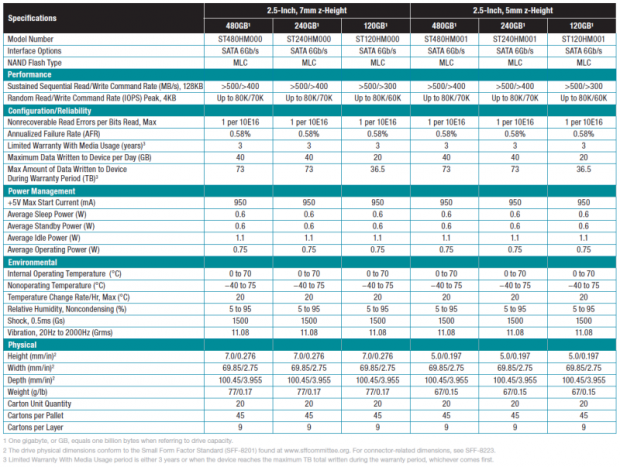
The 5mm thick Seagate 600 series SATA III SSD is available in three capacity sizes: 120GB, 240GB, and 480GB. Specifications list the 480GB 600 Series SSD as capable of exceeding 500MB/s sequential reads, and exceeding 400MB/s sequential writes.
Random read/write speed is listed at up to 80,000/70,000 IOPS, at 4K QD32. A 5mm z-height allows for greater compatibility with newer laptops than any 2.5 inch form factor SATA based SSD upgrade to date.
Seagate backs their 600 series SSD's with an industry standard, three year limited warranty. The 480GB Seagate 600 is currently available from Amazon for $341 (71 cents per GB). Since this is a RAID review, we are going to focus on performance rather than features.
For a more in-depth look at the Seagate 600's feature set, I will refer you to Chris Ramseyer's extensive review of the Seagate 600 480GB SSD.
Seagate 600 480GB SSD
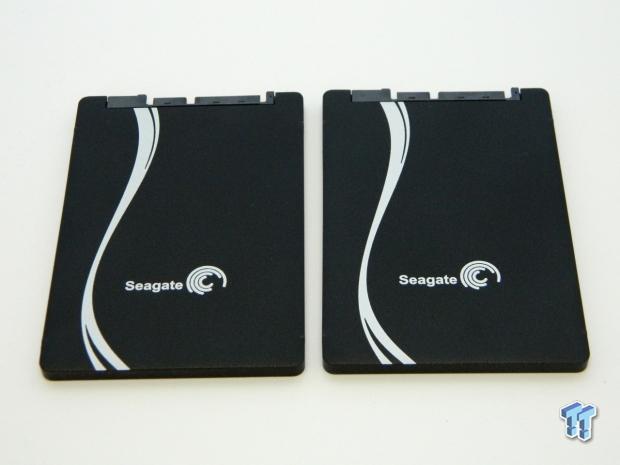
Our drives arrived bare, so we don't have anything to show you as far as packaging goes. The top and sides of the enclosure are formed from a single piece of cast, glass beaded aluminum, which has been painted black. There is an attractive white wave graphic running across the top of the enclosure, and a white Seagate logo beside it.
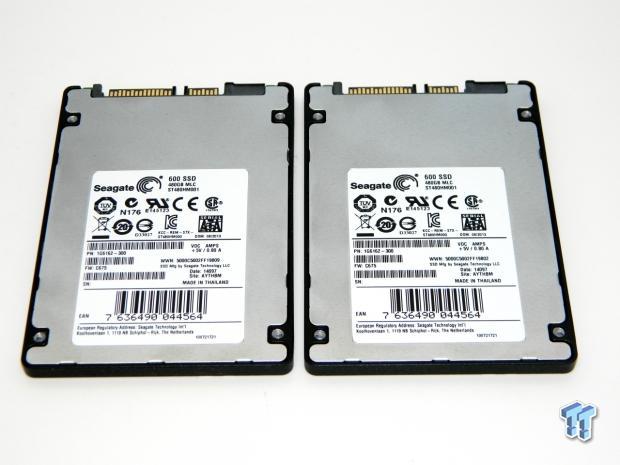
The bottom of the drive's enclosure is formed from a piece of sheet metal. The bottom of the enclosure interlocks with the top, making it tamper proof. Centered on the bottom of the enclosure, is a manufacturer's sticker that lists the drive's part number, serial number, shipping firmware, and other relevant information.
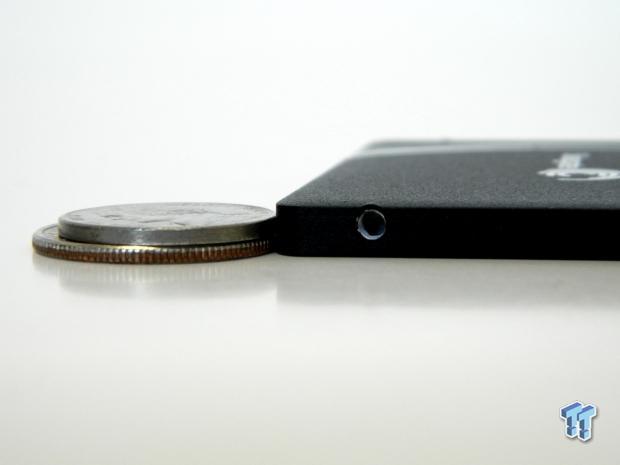
This shot gives you an idea of just how thin a 5mm drive really is. The drive is slightly thicker than a nickel stacked on top of a quarter.
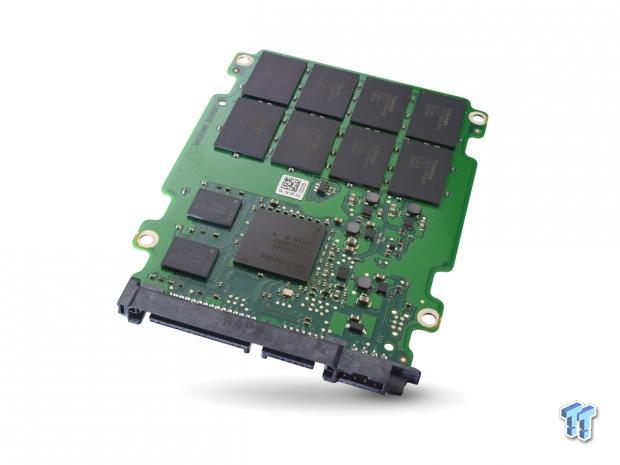
Normally we would disassemble our test subject to show you the internals, but not this time. We know from previous experience that opening a Seagate 600 SSD practically destroys the enclosure. Like I stated earlier, these 5mm review samples are the most elegant drives I've ever held in my hand, and being as such, I couldn't bring myself to destroying one of these works of art. Thankfully, Seagate was kind enough to provide us with an internal photo of a 600 series PCB (pictured above), so we didn't have to rip one open to show you what's on the inside.
The drive's NAND array is located entirely on this side of the PCB, along with 2 DRAM buffer chips, and a LAMD Amber LM87800 FSP (Flash Storage Processor). The reverse side of the PCB is devoid of components. We assume that Seagate employed a thermal pad to wick heat from the drives controller, into its enclosure.
Benchmarks - Test System Setup, Drive Properties & ATTO Baseline Performance
Desktop Test System
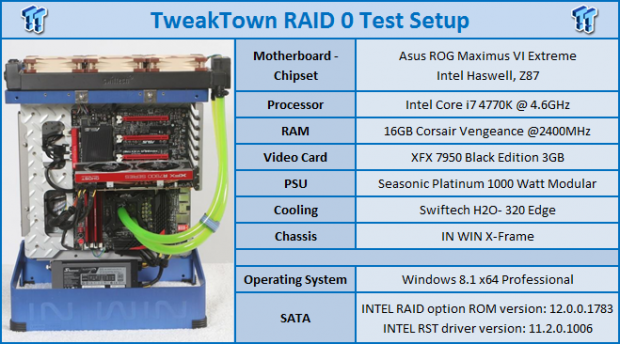
Drive Properties
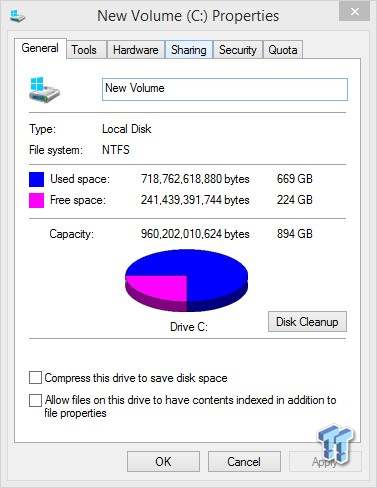
The majority of our testing will be done with our test drive/array as our boot volume. Our boot volume is 75% full for all OS Disk "C" drive testing, in order to mimic a typical consumer OS volume implementation. We're using 64K stripes for all of our arrays. Write caching is enabled.
Our testing includes charting the performance of a single drive, as well as a RAID 0 array of our test subject/s. We are utilizing Windows 8.1 64 Bit OS for all of our testing.
ATTO Baseline Performance
Version and / or Patch Used: 2.47
ATTO is a timeless benchmark used to provide manufacturers with data used for marketing storage products.
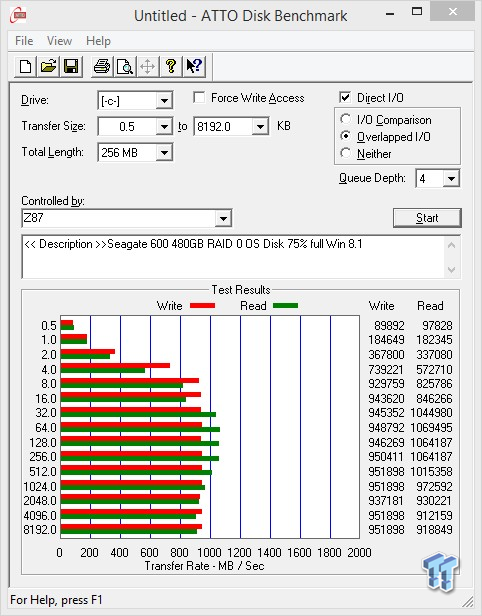
Our two drive array's performance ramps up quickly, with performance peaking between 32K - 256K transfers. Extremely small transfer sizes of 0.5K - 2.0K, benefit most from RAID, in comparison to a single drive, where write caching boosts performance by about 10x in comparison to a single drive.
Sequential Write
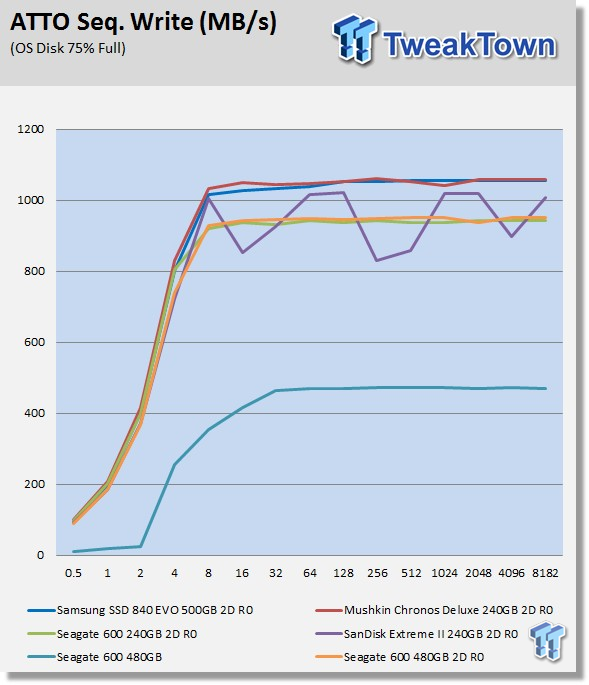
Sequential write performance is very close to that of the 240GB 600 series array, as expected. When we compare 600 series arrays, we see the smaller capacity array's performance ramps up a little faster, and the larger capacity array has a slightly higher peak performance.
Sequential Read
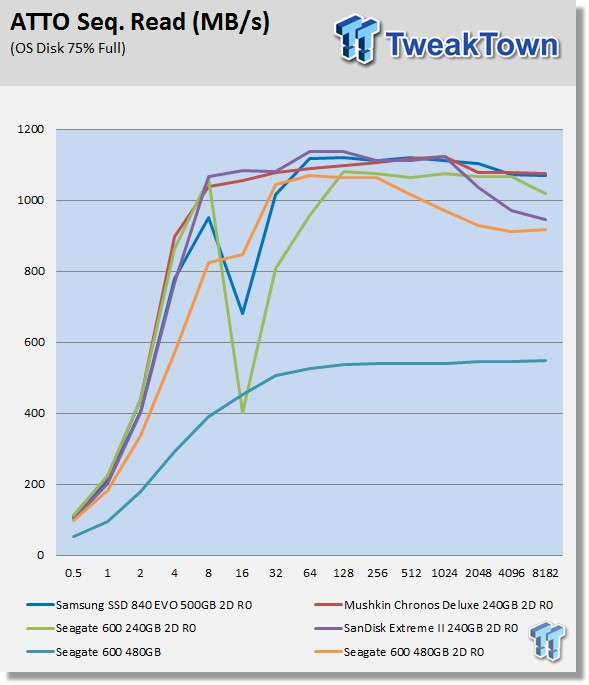
Sequential read performance again shows a different performance curve between our smaller capacity 600 series array, and the larger capacity 600 series array that we're benching today. The smaller capacity array's performance ramps up faster, but drops off at 4K transfers, where the larger capacity 600 series array has the clear advantage with transfer sizes of 8K to 64k.
Benchmarks - Anvil Storage Utilities
Anvil Storage Utilities
Version and / or Patch Used: RC6
So, what is Anvil Storage Utilities? First of all, it's a storage benchmark for SSD's, and HDD's, where you can check and monitor your performance. The Standard Storage Benchmark performs a series of tests; you can run a full test, just the read or the write test, or you can run a single test (i.e. 4K QD16).
The software is used several different ways, and to show different aspects for each drive. We've chosen to use this software to show the performance of a drive with two different data sets. The first is with compressible data, and the second data set is incompressible data. Several users have requested this data in our SSD reviews.
0-Fill Compressible Data
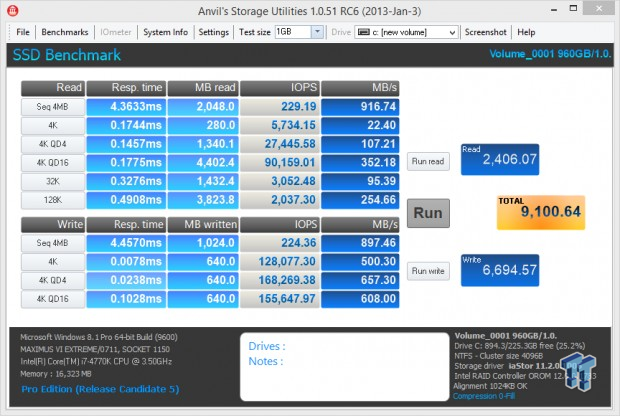
9100 points puts our 600 Series array squarely in the enthusiast-class of SSD's.
0-Fill Compressible Read IOPS through Queue Depth Scale
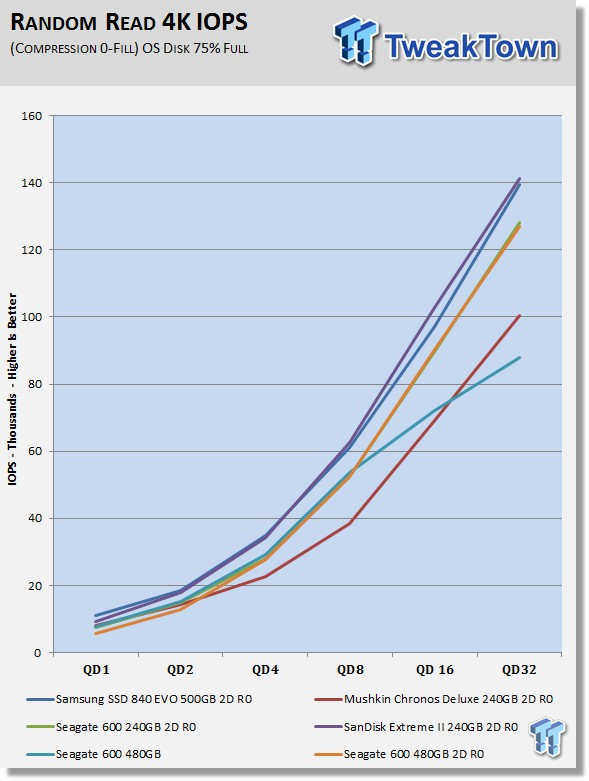
As we would expect to see, our 480GB 600 Series pair array has nearly identical performance to a pair of 240GB 600 series. It's hard to see the green line on the chart, because it's covered by the orange line almost exactly.
0-Fill Compressible Write IOPS through Queue Depth Scale
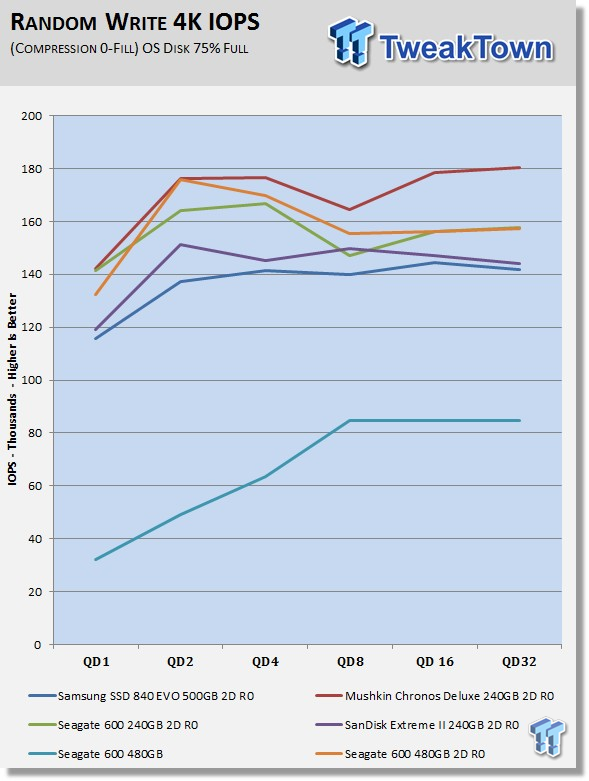
LAMD controlled arrays are write-centric, and can outperform all but our SandForce based array in this test. Here, we see that the larger capacity 600 series array has a different performance curve than the smaller capacity 600 array.
Compression 100% Incompressible Data
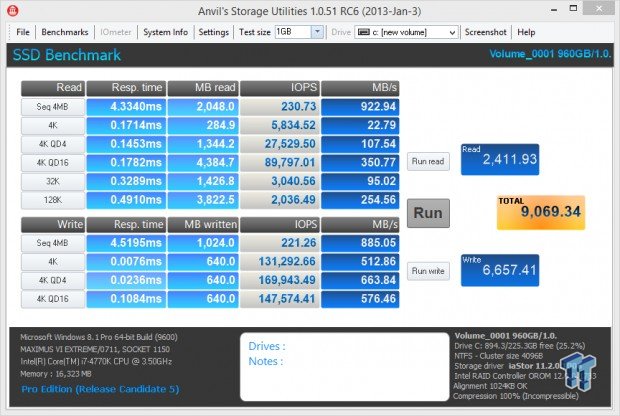
A 600 series array displays no discernable difference in performance, whether or not data is compressible, or incompressible.
Incompressible Read IOPS through Queue Depth Scale
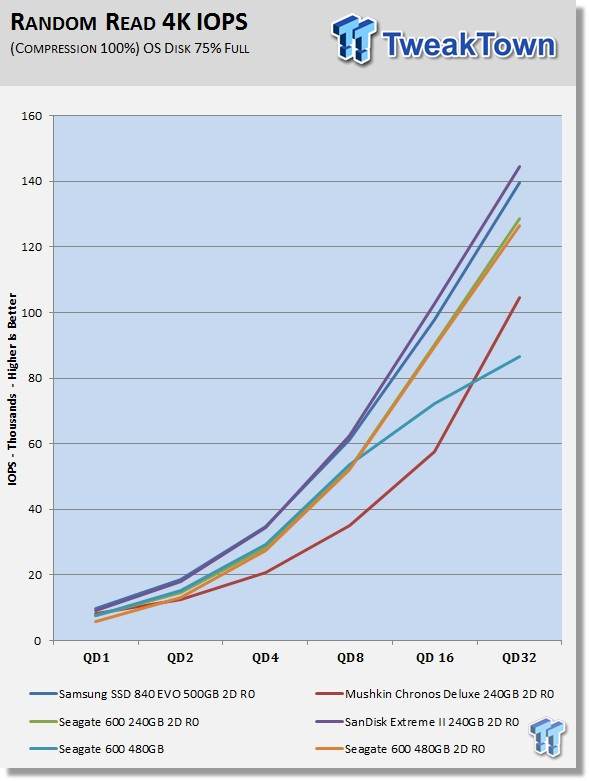
Our 600 series arrays come in third place on our chart when reading data. The SandForce array on our chart is having trouble with the incompressible data used for this test.
Incompressible Write IOPS through Queue Scale
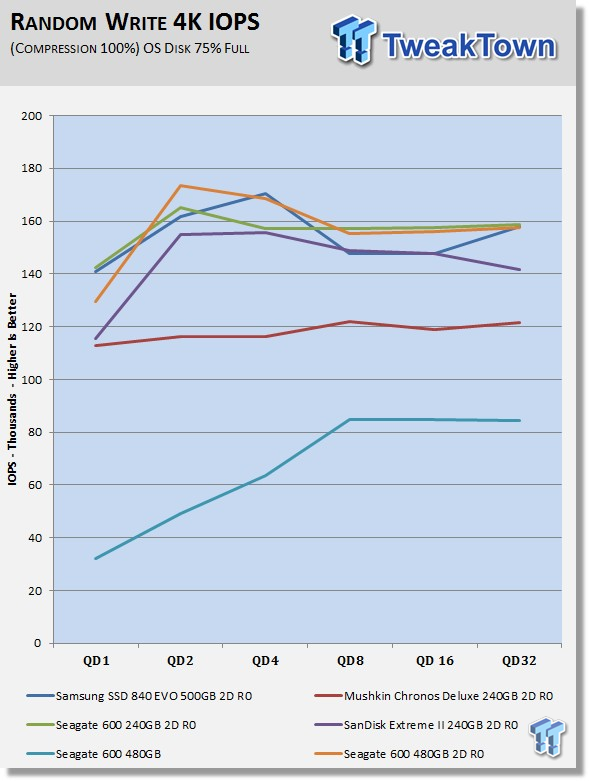
We are going to call this a win for our large capacity 600 series array. Nothing on our chart can outperform a large capacity 600 series array, when writing incompressible data. Writing incompressible data is a huge part of how your array will be utilized in a normal enthusiast workload environment.
Benchmarks - CrystalDiskMark
CrystalDiskMark
Version and / or Patch Used: 3.0 Technical Preview
Developer Homepage: http://crystalmark.info
Product Homepage: http://crystalmark.info/software/CrystalDiskMark/index-e.html
Download here: http://crystaldew.info/category/software/crystaldiskmark
CrystalDiskMark is disk benchmark software that allows us to benchmark 4K, and 4K queue depths with accuracy.
Note: Crystal Disk Mark 3.0 Technical Preview was used for these tests, since it offers the ability to measure native command queuing at 4 and 32.
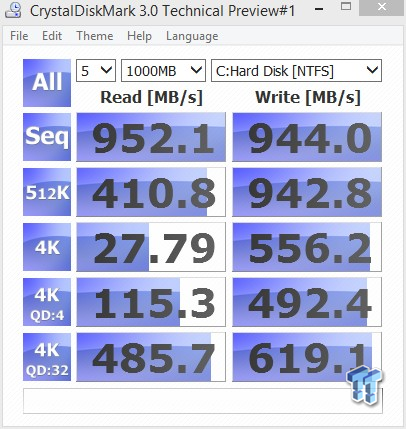
Across the board, write performance is outstanding.
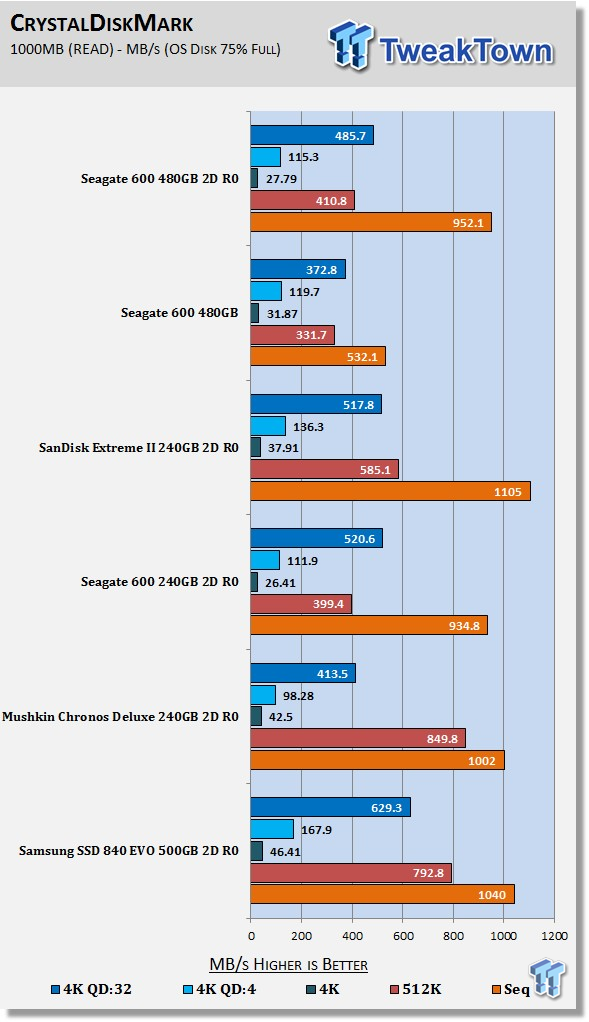
Read performance is where the 600 Series takes a back seat to the other drives on our chart. Our 480GB two drive 600 series array is able to outperform the smaller capacity 600 series array.
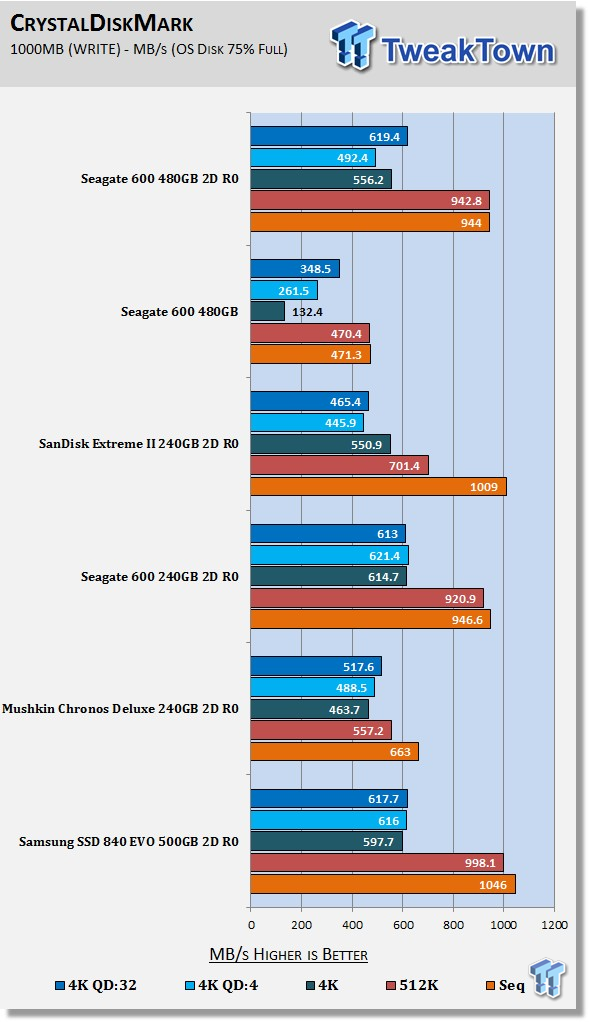
Sequentially, a larger capacity 600 series array outperforms a similar smaller capacity 600 series array; however, the smaller capacity array is able to put up slightly superior random write numbers. Here, we see that both 600 series arrays can outperform the Extreme II.
Our EVO array is able to put up slightly better numbers, but that's only because this test doesn't exceed the EVO array's "Turbo Write" emulated SLC layer.
Benchmarks - AS SSD
AS SSD
Version and / or Patch Used: 1.7.4739.38088
Product Homepage: http://alex-is.de/PHP/fusion/news.php
Download here: http://alex-is.de/PHP/fusion/downloads.php
AS SSD determines the performance of Solid State Drives (SSD). The tool contains four synthetic tests, as well as three practice tests. The synthetic tests are used to determine the sequential and random read and write performance of the SSD. These tests are carried out without the use of the operating system caches.
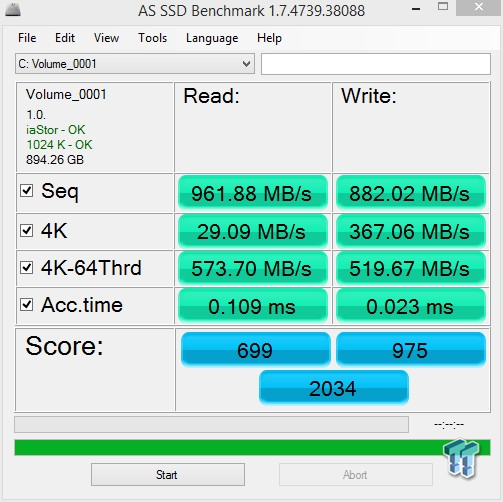
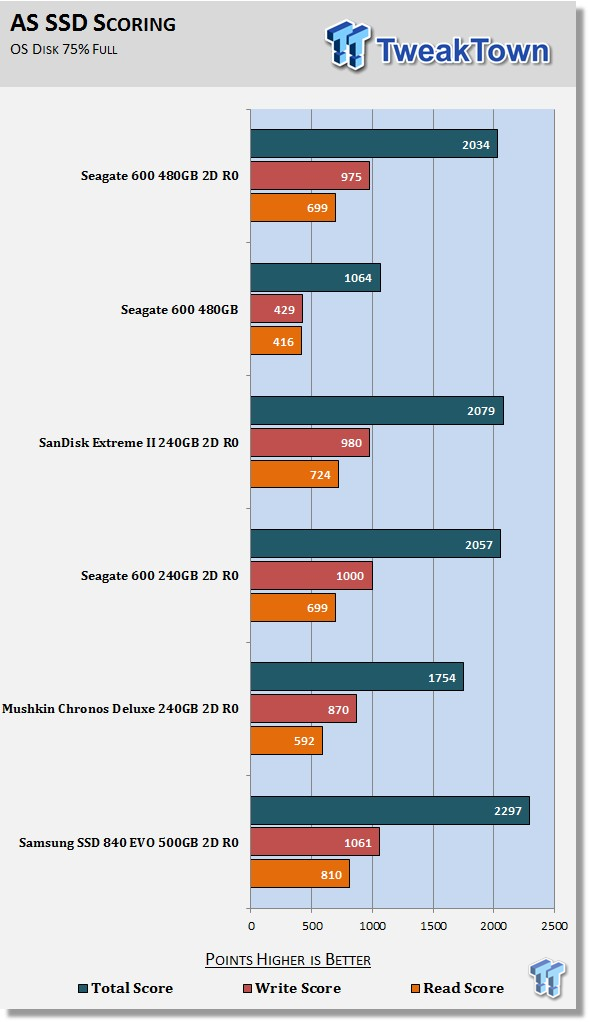
Our two drive 600 series array is able to nearly double the score of a single drive.
Benchmarks - PCMark Vantage
PCMark Vantage - Hard Disk Tests
Version and / or Patch Used: 1.2.0.0
Developer Homepage: http://www.futuremark.com
Product Homepage: http://www.futuremark.com/products/pcmarkvantage

PCMark Vantage is the first objective hardware performance benchmark for PCs running 32, and 64 bit versions of Microsoft Windows Vista. PCMark Vantage is perfectly suited for benchmarking any type of Microsoft Windows Vista PC, from multimedia home entertainment systems and laptops, to dedicated workstations and high-end gaming rigs. Regardless of whether the benchmarker is an artist, or an IT Professional, PCMark Vantage shows the user where their system soars, or falls flat, and how to get the most performance possible out of their hardware. PCMark Vantage is easy enough for even the most casual enthusiast to use, yet supports in-depth, professional industry grade testing.
The reason we like PCMark Vantage, is because the recorded traces are played back without system stops. What we see is the raw performance of the drive. This allows us to see a marked difference between scoring that other trace based benchmarks do not exhibit. An example of a marked difference in scoring on the same drive would be empty vs. filled vs. steady state.
We run Vantage in three ways. The first run is with the OS drive/Array 75% full, to simulate a lightly used OS volume filled with data to an amount that we feel is common for most users. The second run is with the OS volume written into a "Steady State," utilizing SNIA's guidelines (Rev 1.1). Steady state testing simulates a drive/array's performance similar to that of a drive/array that has been subjected to consumer workloads for extensive amounts of time. The third run is a Vantage HDD test, with the test drive/array attached as an empty, lightly used, secondary device.
OS Volume 75% full - Lightly Used
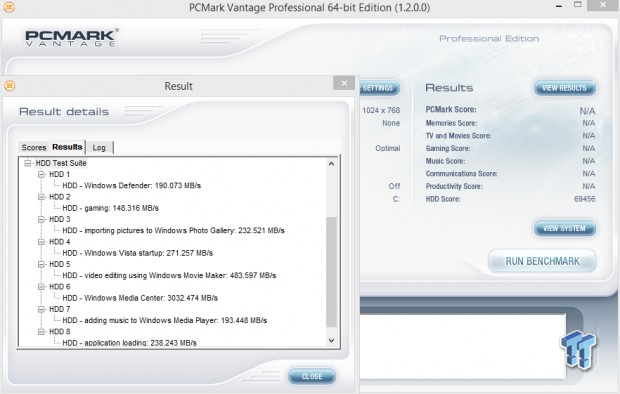
OS Volume 75% full - Steady State
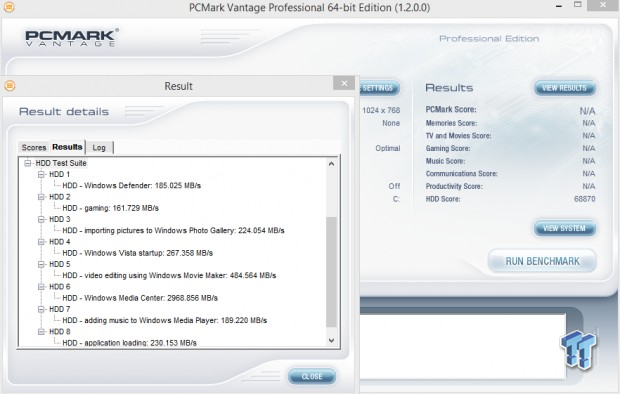
Secondary Volume Empty - Lightly Used
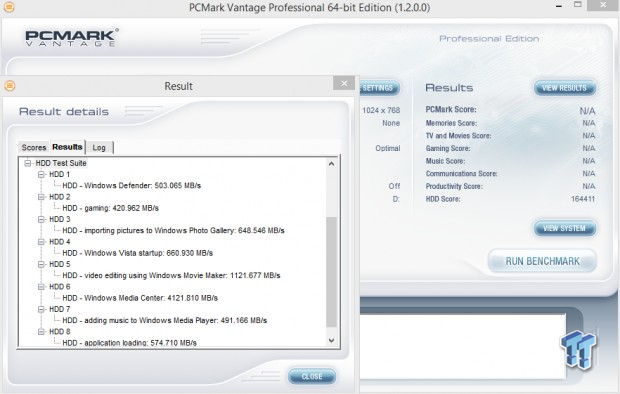
As you can see, there's a big difference between an empty drive/array, one that's 75% full/used, and one that's in a steady state.
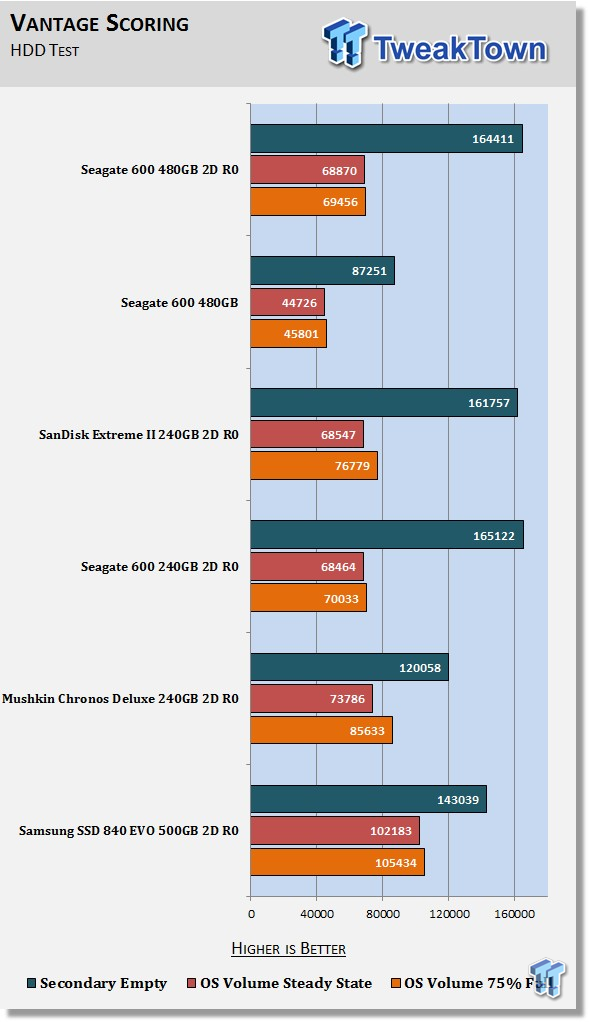
The important scores to pay attention to are "OS Volume Steady State," and "OS Volume 75% full". These two categories are most important because they are indicative of typical consumer based user states.
When a drive/array is in a steady state, it means garbage collection is running at the same time it's reading/writing. There is a huge difference in performance between a single drive, and a two drive array. Notice that there is almost no loss of performance between 75% filled/lightly used, and a steady state. This is exactly why we love LAMD controlled drives: unmatched consistency.
Benchmarks - PCMark 7
PCMark 7 - System Storage
Version and / or Patch Used: 1.4.00
Developer Homepage: http://www.futuremark.com
Product Homepage: http://www.futuremark.com/benchmarks/pcmark7
PCMark 7 includes seven PC tests for Windows 7 & 8; combining more than 25 individual workloads covering storage, computation, image and video manipulation, web browsing, and gaming. Specifically designed to cover the full range of PC hardware from netbooks and tablets, to notebooks and desktops, PCMark 7 offers complete PC performance testing for Windows 7 & 8 for home, and business use.
We will look to the RAW system storage scoring for RAID 0 evaluations, because it's done without system stops, and therefore allows us to see significant scoring differences between drives/arrays.
OS Volume 75% full - Lightly Used
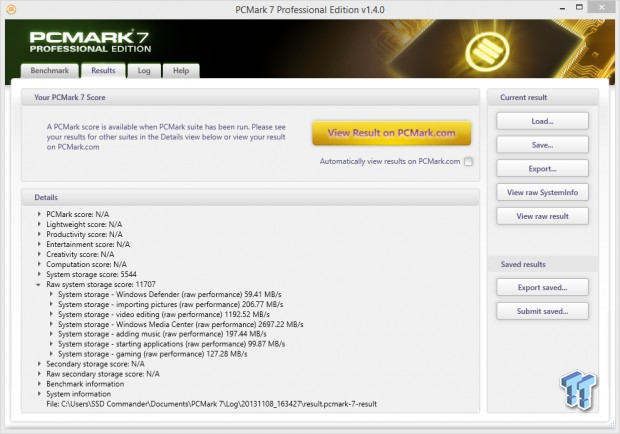
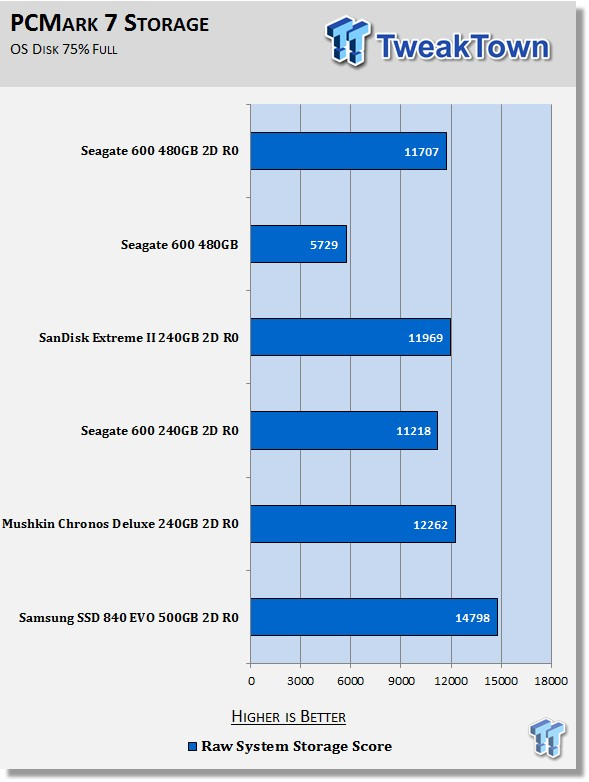
Just as we saw with our Vantage testing, there is a huge difference between a single drive, and a two drive array. The 600 series has nearly identical performance to the Extreme II array in this test. The larger capacity 600 series array is able to outperform the smaller capacity 600 series array in this scenario.
Benchmarks - PCMark 8
PCMark 8 - Storage Bandwidth
Version and / or Patch Used: 1.2.157
Developer Homepage: http://www.futuremark.com
Product Homepage: http://www.futuremark.com/benchmarks/pcmark8
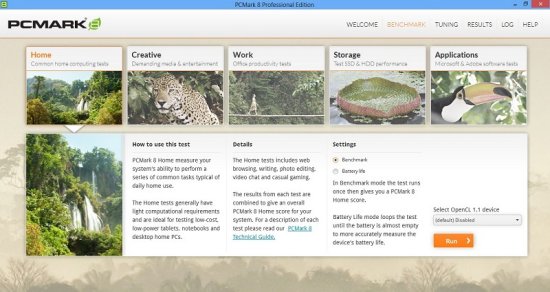
PCMark 8 is FutureMark's latest version of their popular series of PC benchmarking tools. PCMark 8 improves on previous releases by including battery life measurement tools, and new tests using popular applications from Adobe and Microsoft. Whether you are looking for long battery life, or maximum power, PCMark 8 helps you find the devices that offer the perfect combination of efficiency, and performance for your needs.
Use the PCMark 8 Storage benchmark to test the performance of SSDs, HDDs, and hybrid drives, with traces recorded from Adobe Creative Suite, Microsoft Office, and a selection of popular games. You can test the system drive, or any other recognized storage device, including local external drives. Unlike synthetic storage tests, the PCMark 8 Storage benchmark highlights real-world performance differences between storage devices.
PCMark 8's Storage Performance Benchmark is an absolute beast of a test. The benchmark beats the hell out of your drive/array for well over an hour, resulting in a very thorough evaluation of a drive/array's real-world performance.
OS Volume 75% full - Lightly Used
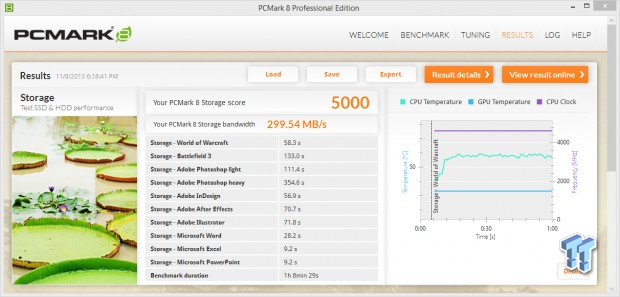
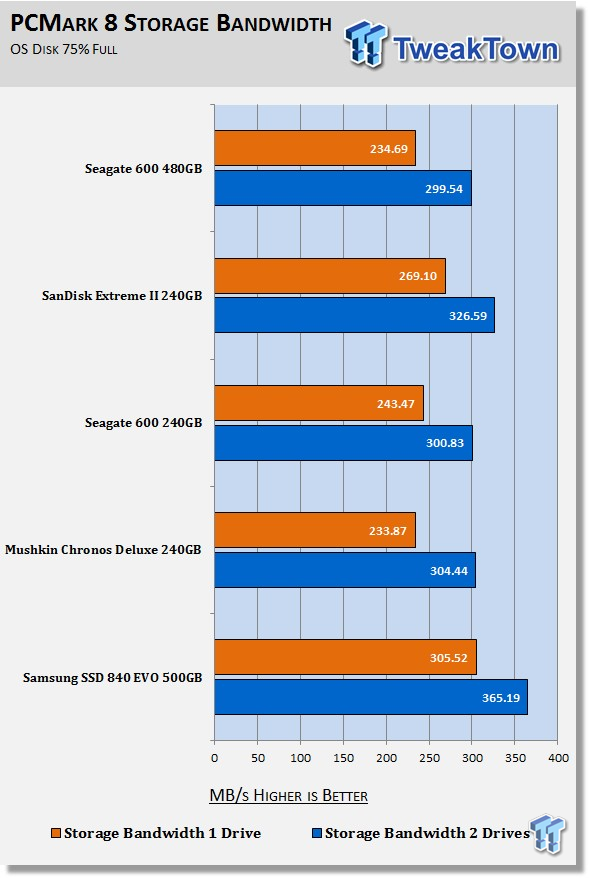
The enthusiast-class arrays (Chronos and 600 Series) on our chart are closely matched, with no real difference between them. The two hyper-class arrays (Extreme II and EVO) on our chart have more storage bandwidth than the 600 series, and Chronos arrays.
Secondary Volume Benchmarks - Blackmagicdesign's Disk Speed Test
Disk Speed Test
Version and / or Patch Used: 2.1.1
Product Homepage: http://www.blackmagicdesign.com
Disk Speed Test is an easy to use tool to quickly measure, and certify, your disk performance for working with high quality video! Simply click the start button, and Disk Speed Test will write test your disk using large blocks of data, and then display the result. Disk Speed Test will continue to test writes and reads from your disk, so you can evaluate both performance, and readability, over time.
We rate a drive/array's video capabilities by the number of different categories that the device is capable of passing. The maximum number of tests that are possible to pass are 45 write tests, and 45 read tests. We chart the number of tests a disk/array is capable of passing, for a comparison of one drive/array verses another.
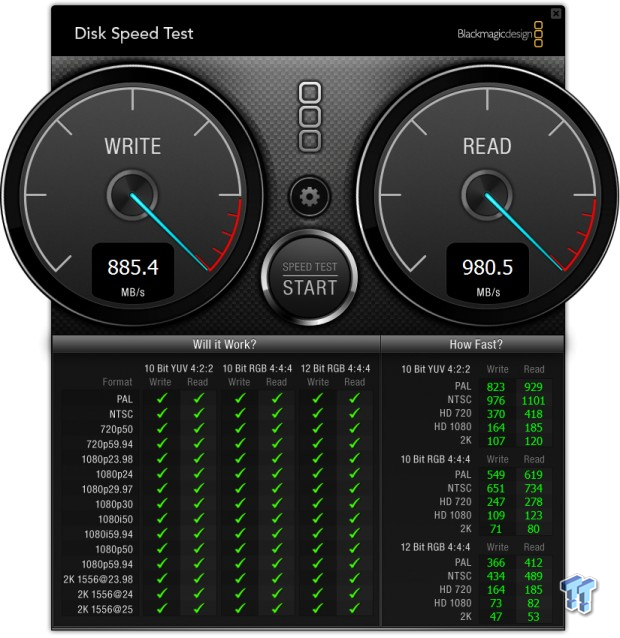
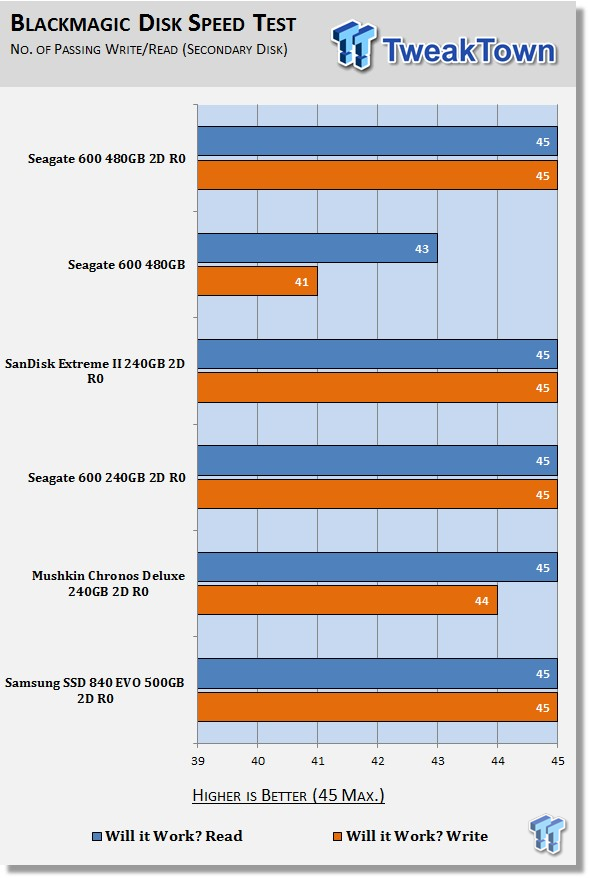
It's very hard for a single drive to be completely HD video capable. This is why serious video processing is done almost exclusively utilizing RAID arrays. Sequential incompressible performance is the name of the game when it comes to video processing.
A 600 series array, not surprisingly, is completely HD video capable. Even though there are other slightly faster arrays, we prefer a 600 series array over all others for video processing. The reason we prefer a 600 series array in this scenario? Simple: consistent performance over time.
Secondary Volume Benchmarks - Disk Response Times
Iometer
Version and / or Patch Used: 1.1.0
Product Homepage: http://www.iometer.org
Download here: http://sourceforge.net/projects/iometer
Iometer is an I/O subsystem measurement, and characterization tool, for single and clustered systems. It was originally developed by the Intel Corporation, and announced at the Intel Developers Forum (IDF) on February 17, 1998. Since then, it's become wide spread within the storage industry.
We use Iometer to measure disk response times. Disk response times are measured at an industry accepted standard of 4K QD1 for both write, and read. Each test is run twice, for 30 seconds consecutively, with a five second ramp-up before each test. The drive/array is partitioned and attached as a secondary device for this testing.
Write Response
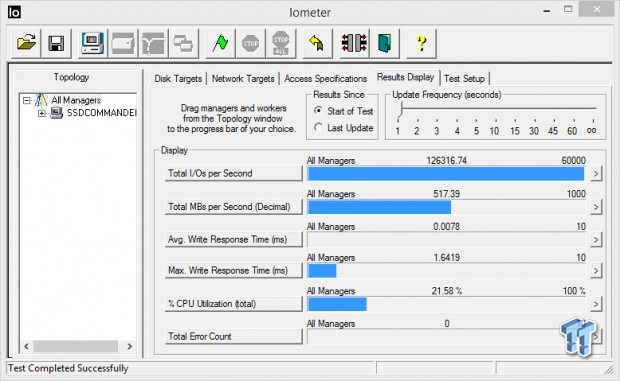
Read Response
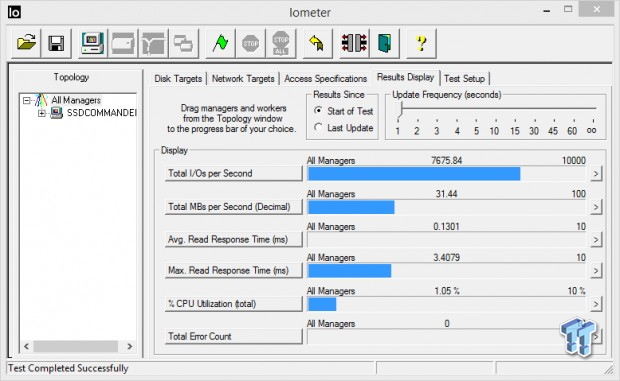
Average Disk Response
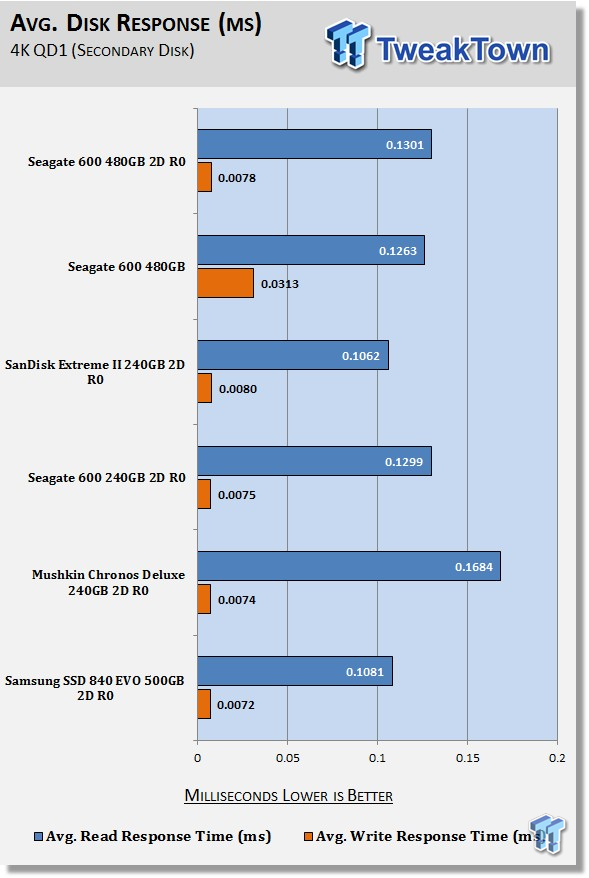
Write response times benefit most from RAID 0 because of write caching. There is a slight latency increase in read response times for an array vs. a single drive. Both 600 series arrays on our chart have superior write response performance to our Extreme II array. Read response times are better; much better than our Chronos array, but not as good as our Extreme II, and EVO arrays.
Secondary Volume Benchmarks - DiskBench
DiskBench - Directory Copy
Version and / or Patch Used: 2.6.2.0
Developer Homepage: Nodesoft
Product Homepage: DiskBench
Download here: http://www.nodesoft.com/diskbench/download
We use DiskBench to time a 28.6GB block (9,882 files in 1,247 folders) of mostly incompressible random data, as it's transferred from our OS array, to our test drive/array. We then read from a 6GB zip file that's part of our 28.6GB data block, in order to determine the test drive/array's read transfer rate. The system is restarted prior to the read test to clear any cached data; insuring an accurate test result.
Write Transfer Rate
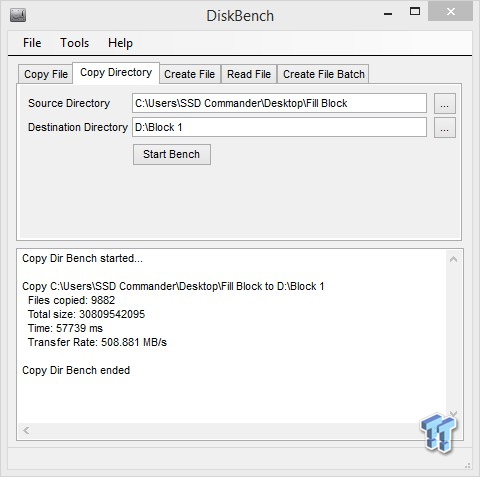
The 600 series real-world, random write performance is class leading.
Read Transfer Rate
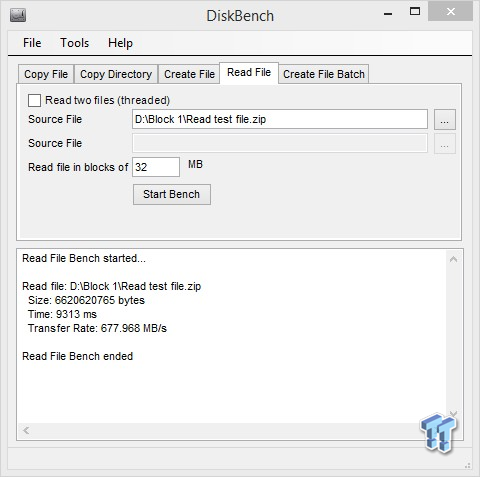
The larger capacity 600 series array has better read transfer performance than the smaller capacity 600 array. Read transfers are slower than the other array's on our chart.
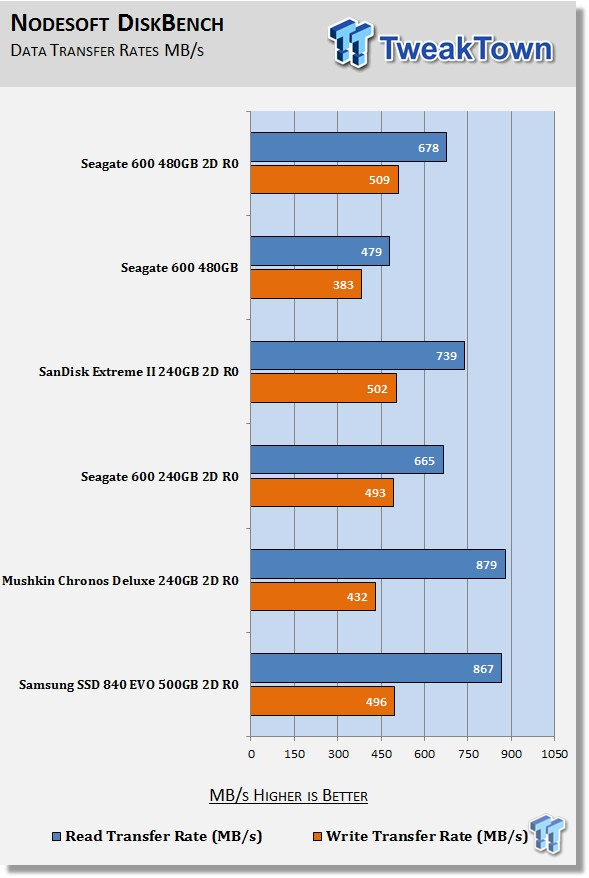
This test is definitely where the rubber meets the road. This is a huge chunk of random incompressible data that we're transferring. The pair of 480GB Seagate 600 series SSD's have the best write transfer rate of any two drive SATA based arrays we've ever tested.
Final Thoughts
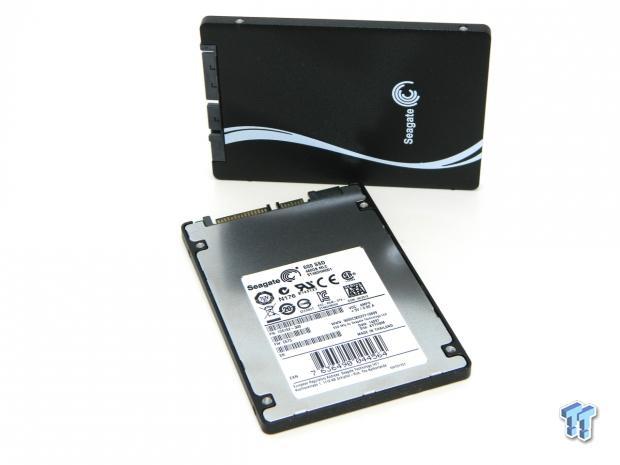
Solid state storage is the most important performance component found in a modern system today. Without it, you do not even have a performance system.
It's hard to put into words just how elegant high capacity enthusiast solid state storage really is when it comes in a 2.5" 5mm, z-height form factor. I suppose if I had one word to describe the Seagate 600 series in 5mm z-height, it would be "sexy".
The only thing sexier is when you RAID 0 a pair of these works of art. Looks are great, but a piece of hardware must have performance to match, and Seagate's 600 series delivers there as well. The 600 series is what we consider "Enthusiast-Class" which is faster than "Mainstream-Class" and not quite as fast as "Hyper-Class".
The 600 series is "write-centric," and while it's a very capable performer when reading data, there are faster solutions. However, when it comes to writing large amounts of random data, a Seagate 600 series RAID 0 array is faster than any SATA based array we've come across to date. Unmatched consistency, and superior write performance, are the reasons the 600 series has been, and continues to be, a TweakTown favorite.
RAIDing two or more drives together provides you with storage that takes performance to the next level, and is something I recommend you try. Once you go RAID, there's no going back.

